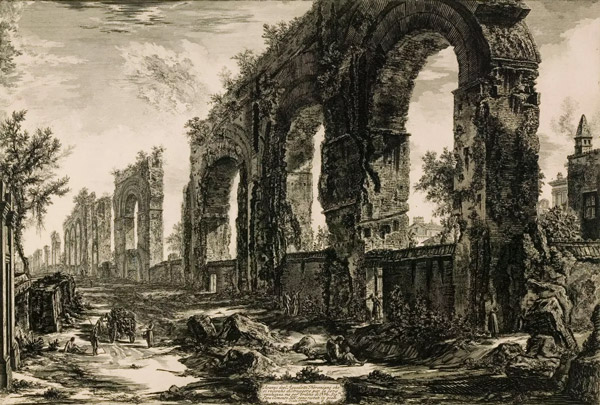

24777 views

| Tip | The park is public and has over 15 hectares to visit at any time of the day. However, the best time to visit is at dawn or sunrise to see the beauties of the aqueducts and take great photos. |
|---|---|
| Recommended tour | |
| Closest bus stops |
|
| Closest subway stations |
|
| Address | Via Lemonia, Roma |
| Website | www.parcoappiaantica.it |
Ancient Park of the Aqueducts (Parco degli Acquedotti) in Rome is located just outside the city on the Appian Way.
The Roman water system consisted of artificial channels to convey water and run for some or all of their path through underground tunnels. In addition, three Roman aqueducts allowed Roman inhabitants to receive 1.000 liters of water per person daily in 52 A.D.
Contents
ToggleThe Romans constructed aqueducts that served as Roman water systems throughout the Empire. The water supplied public baths, fountains, restrooms, gardens, milling, farms, and private households. The constructions moved water through gravity alone, for the most part along a slight descending downward gradient inside conductors of stone, brick, or concrete, yet some of the time through steeper gradients.
Most conduits were covered underneath the ground and took after the contours of the terrain. In addition, most aqueduct systems included sedimentation tanks, which helped reduce any water-borne debris. However, the construction’s run-off water drove urban water processes and scoured the channels and sewers.
Ancient Romans constructed complex water systems that supplied the city with massive water. The aqueducts that are considered ancient Roman ones were built over five centuries. Moreover, from 311 B.C. to 226 A.D., 11 of them were created. During the height of the Roman Empire, these water systems delivered approximately one million gallons of water a day to the Eternal City.
Even today, you can see beautiful constructions that surround the city. The aqueducts had a very complex system, and nowadays, the Park of the Aqueducts is one of the most excellent options were to spending a sunny day in Rome. One interesting fact is that the first aqueducts to serve Rome were the 16 km long Aqua Appia (312 BCE), the Anio Vetus (272-269 BCE), and the 91km long Aqua Marcia (144-140 BCE).
Emperor Caligula commissioned the Claudian Aqueduct (Aqua Claudia) in 52 A.D. With Aqua Anio Vetus, Aqua Anio Novus, and Aqua Marcia, it is considered one of the “four great aqueducts of Rome.” Building the aqueduct took 11 years and more than 30 thousand workers. Moreover, it was considered the provider of the best water in the city. Nowadays, it has the most outstanding remains, and you can see them at Aqueduct Park and Porta Maggiore.
Moreover, the aqueduct required repairs after its creation and was reconstructed for 9 years. It was finally completed in 71 A.D. by Vespasian. However, the aqueduct was repaired again under the commission of Titus in 81 A.D. Its source was several springs in the Anio Valley.
The aqueduct was 45 miles long.
The Acqua Felice was the first aqueduct built during the Roman Renaissance. It was commissioned by Pope Sixtus V, whose birth name was Felice Peretti. Also, it was the first new aqueduct in early modern Rome. Moreover, the Acqua Felice runs for 8 miles underground plus 7 miles above the ground and reaches its final point at the Moses Fountain (Fontana dell’Acqua Felice). Domenico Fontana designed it in 1587.
The three-arched fountain marked the entry of the new water source into Rome.
Villa of the Vineyards (Villa delle Vignacce) was a massive construction in ancient Rome located in the Aqueduct Park. It was constructed in the 2nd century A.D. and reconstructed in the 4th century A.D. However, it is considered one of the city’s less documented villas. Moreover, according to the excavations made in 2007, there were baths and heating systems during the construction. The bath complex had mosaic floors and marble walls. Also, there were different statues, and water cascades inside. Nowadays, you can see the extensive ruins in Rome’s largest public park with the aqueducts.
The first aqueducts were built by old civic establishments, such as those in Babylon, Assyria, and Egypt. These water systems were built as open canals uncovered between a river and a city. However, the most famous water passages were created by the Romans.
Caesarea was a port city built by King Herod the Great between 23-13 B.C. in Israel. The aqueduct brought water to the city from springs 10 km (6 miles) away. In the 2nd century A.D., the Romans expanded the ancient aqueduct and doubled its capacity. Also, the structure continued to supply water for 1200 years and was repaired several times.
The Valens Aqueduct was constructed in the year 368 A.D. during the reign of Roman Emperor Valens. It served as one of the terminal points of a system of ancient aqueducts and canals of Constantinople (today, Istanbul, Turkey). Moreover, the water system reached over 250 km (155 miles) in total length and was the longest aqueduct in Antiquity. Today, the surviving section is 921 meters (3021 feet) long.
The Aqueduct of Segovia, built around 50 A.D., is one of the best-preserved monuments left by the Romans in Spain. It is 16 km (10 miles) long and was constructed of some 24 thousand massive granite blocks without mortar. Moreover, it is the symbol of Segovia, which provided water up until the 20th century.
The magnificent Park of the Aqueducts in Rome is one of the city’s most beautiful and peaceful sites. It would be great to come there for a picnic, photoshoot, or enjoy a day during warm weather. Moreover, there is enough space to run or do sports.

Author: Kate Zusmann
This website uses cookies. For more info read the cookies policy
Rome.us © 2025. Created with love by Roman experts and guides.